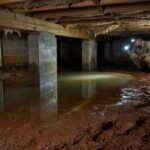Essential Guide to Effective Basement Waterproofing Techniques for Homeowners
Welcome to the world of basement waterproofing, where dampness meets its match and homeowners reclaim their space from the clutches of mold, mildew, and that pesky smell of wet dog—the kind you didn’t even own! Whether you’re a first-time homeowner or a seasoned pro, understanding basement waterproofing can save you time, money, and a great deal of frustration. So grab your rubber gloves, and let’s dive into this essential guide to effective basement waterproofing techniques!
Understanding the Importance of Basement Waterproofing
Before we start discussing techniques, let’s take a moment to appreciate why basement waterproofing is crucial. Water in your basement can lead to a plethora of issues—structural damage, health risks from mold, and a general sense of doom when you walk past your once-pristine space. A leaky basement isn’t just an inconvenience; it can significantly devalue your home. In fact, it’s often said that a dry basement is a happy basement!
By investing in efficient waterproofing methods, you’re not only preserving the foundation of your home but also enhancing its overall value. So, what are the options available to keep the water at bay? Let’s break down the most effective techniques.
1. Interior Waterproofing
Interior waterproofing techniques focus on keeping the water out from inside the basement. One of the most popular methods is installing a **drainage system**. This often involves placing perimeter drains along the foundation walls to collect water before it can infiltrate your living space. These drains typically redirect water to a sump pump or away from the foundation entirely. Remember, proper installation is key; poorly installed drainage systems can lead to more problems down the line. Talk about a real “oops” moment!
Sump pumps are crucial components of an interior waterproofing plan. They actively pump out any water that collects in the sump pit, which is usually dug at the lowest point of your basement. It’s like having a trusty sidekick committed to preventing a flood every time it rains. Be sure to select a reliable model with battery backup options; after all, you don’t want your only line of defense taking a nap during a thunderstorm!
2. Exterior Waterproofing
If you want to tackle the problem from its source (and perhaps avoid indoor plumbing adventures), exterior waterproofing is the way to go. This technique involves digging around your home’s foundation to expose the exterior walls. Once exposed, it’s time to apply a waterproof coating or sealant directly on the wall. Think of it as giving your foundation a nice waterproof “sunscreen” layer to shield it from the elements.
Another critical aspect of exterior waterproofing is managing the grading of your property. Ensure that the ground slopes away from your foundation, encouraging rainwater to flow away rather than pooling around your home. Consider planting some greenery or landscaping elements that guide water away; Mother Nature loves a good water diversion scheme!
3. Sealing Cracks and Leaks
Like pesky little critters sneaking through cracks, water can find its way into your basement through even the tiniest openings. Conducting regular inspections for cracks in your foundation is essential. If you spot any, don’t panic—there are plenty of ways to seal them up!
Patch up small cracks with hydraulic cement, which expands as it dries, filling those gaps tightly. For larger cracks, you might need to turn to epoxy injection methods. And if you’re dealing with leaky joints or gaps in walls, specific sealants can do wonders. Once you’ve sealed up holes, consider applying a waterproof membrane over the walls for added protection—think of it as wearing double layers in winter!
4. Installing a French Drain
When it comes to basement waterproofing, a French drain is a true classic. This method involves installing a trench filled with gravel that redirects water away from your basement. The drainage pipe within the trench collects excess water and safely channels it away from your foundation, preventing saturation.
To install a French drain, you’ll want to dig a trench that slopes away from your home. Line the bottom with gravel, place the perforated pipe inside, and then cover it with more gravel and soil. Voilà! Just remember that while you’re digging, make sure you don’t unearth buried treasure… or worse, hit a utility line. Safety first!
5. Vapor Barriers
Vapor barriers are materials used to prevent moisture from rising through your basement floor and walls. They’re particularly useful in homes with high humidity levels. A common choice is polyethylene sheeting, which can be laid down before pouring a concrete slab or placed on existing floors.
The key with vapor barriers is ensuring they are properly secured and sealed. You want to create a fortress against unwanted moisture, and any gaps can allow dampness to seep through. The end result will be a dry basement that feels fresh and welcoming—no musty odor allowed!
6. Maintaining Gutters and Downspouts
Sometimes, the best waterproofing techniques don’t require a full-scale renovation. Regular maintenance of your gutters and downspouts can significantly reduce water intrusion in your basement. Clogged gutters lead to overflow, which can pool near your foundation. To remedy this, clean your gutters regularly and ensure downspouts direct water at least six feet away from your home.
If your home has a tendency towards water pooling, consider extending your downspouts further away or using splash blocks. It’s a simple fix that can lead to fewer headaches—and won’t cost an arm and a leg!
7. Landscaping for Drainage
Landscape design can play a pivotal role in ensuring your basement stays dry. Planting trees and shrubs strategically can help absorb excess moisture from the ground. Utilize swales—shallow trenches—to guide water away from your property. It’s like creating mini-rivers that lead water on a journey far from your foundation…
Additionally, ensure that hardscaping, like patios and walkways, slopes away from your home to assist with natural drainage. Because, let’s face it, no one wants to live in a swamp!
8. Professional Assessment and Help
Sometimes DIY solutions just won’t cut it, and that’s perfectly okay! Hiring a professional who specializes in basement waterproofing can provide tailored solutions for your home. They can conduct thorough assessments to identify vulnerabilities and recommend methods that align with your needs.
While it may seem like an unnecessary expense, think of it as investing in peace of mind. Professionals have the tools and experience to tackle tricky problems that may leave even the most skilled DIYer scratching their head. Plus, they know how to navigate building codes and ensure everything is up to snuff—your local inspector will thank you!
9. Regular Maintenance
Once you have your waterproofing techniques in place, it’s important to keep up with regular maintenance. Schedule periodic checks of your basement for signs of moisture, perform inspections on your sump pump, and keep an eye on your drainage systems.
Being proactive can catch issues before they snowball into massive repairs. And remember: a dry basement is often synonymous with a happy household. So, invest your time now to enjoy the dividends later!
Conclusion
Basement waterproofing might seem daunting at first, but with the right techniques and a bit of elbow grease, you can transform your damp dungeon into a usable, enjoyable space. By understanding the various methods—from interior solutions like sump pumps to outdoor strategies like grading—you can effectively keep water where it belongs: outside your home.
With each step, you’re safeguarding not just your basement but your entire home investment. Now go forth, armed with knowledge and a renewed commitment to bid farewell to puddles and mold. Your dry, happy basement awaits!


